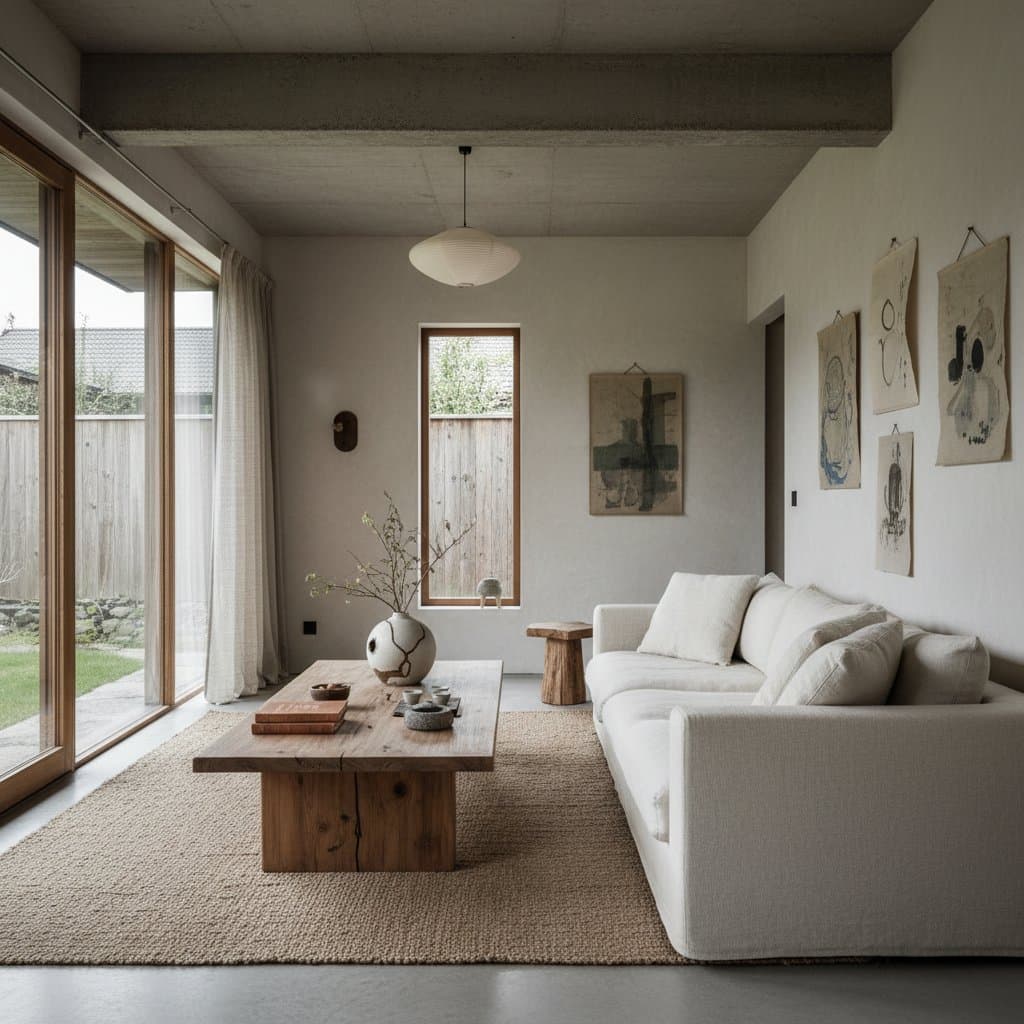The Emergence of Wabi-Sabi in 2025 Interior Design
Consider entering a room where an absence of perfect alignment or pristine condition evokes a profound sense of tranquility. This subtle ease stems from the Japanese concept of wabi-sabi, which honors simplicity, organic textures, and subtle flaws that render environments genuine and inhabited. For those weary of sleek surfaces and idealized layouts, wabi-sabi offers a refreshing approach to infuse homes with authenticity.
The Appeal of Wabi-Sabi for Contemporary Living Spaces
Homeowners increasingly reassess the emotional resonance of their interiors. Rather than pursuing flawless symmetry or lavish materials, emphasis falls on ease, sincerity, and equilibrium. Wabi-sabi aligns seamlessly with this evolution by prompting appreciation for existing elements, regardless of minor wear or asymmetry.
View it as an antidote to the sterile exhibition aesthetic. Elements such as a marked timber floor, artisan-crafted pottery, or subtly weathered upholstery contribute to an inviting, true-to-life ambiance. The objective lies not in fabricating antiquity or rusticity, but in embracing the organic evolution of materials through use.
Fundamental Principles of Wabi-Sabi Design
Grasp the essence of this philosophy before selecting palettes or furnishings. Wabi-sabi rests on three cornerstone principles:
- Simplicity – Retain items that provide utility or significance. Negative space forms an integral design component.
- Natural Materials – Incorporate substances like timber, flax linen, stone, and earthenware. Allow their inherent grains and surfaces to convey character.
- Transience – Recognize the mutable nature of objects. Surface patina or fissures serve as emblems of life's progression, not defects to conceal.
These tenets inform decoration choices, acquisitions, and maintenance practices. They foster a deliberate pace, encouraging deeper valuation of possessions.
Integrating Wabi-Sabi Elements into Your Home
Full-scale overhauls or substantial investments prove unnecessary to adopt this aesthetic. Incremental modifications yield substantial impact. Consider these actionable steps:
-
Declutter with Intention
Examine each room systematically and eliminate non-essential objects. Preserve those with personal resonance or practicality. The intent involves creating breathing room for cherished items, not achieving barrenness. -
Select Organic Finishes
Seek timber displaying pronounced grain, matte ceramics, or interlaced fabrics. Such choices develop gracefully with age and promote serenity. Steer clear of shiny coatings or intricate motifs. -
Employ Subdued, Earthy Tones
Opt for hues reminiscent of sand, rock, terracotta, and softened foliage or azure shades. These form a restful scheme that harmonizes irregularities and facilitates soft illumination diffusion. -
Blend Vintage and Contemporary Pieces
Position a sleek settee beside an aged console. This juxtaposition maintains visual intrigue while anchoring the composition. Prioritize restoration over substitution whenever feasible. -
Prioritize Natural Illumination and Openness
Daylight constitutes a vital wabi-sabi facet. Maintain unobstructed views through windows and select sheer drapery. Arrange seating to accommodate flow and secluded nooks.
Advantages and Challenges of Wabi-Sabi Aesthetics
Every design paradigm presents benefits alongside considerations.
Advantages:
- Generates a serene, hospitable environment
- Promotes intentional habitation and regard for ordinary objects
- Proves economical through repurposing existing assets
- Minimizes optical overload and tension
Challenges:
- Appears austere to enthusiasts of vibrant hues or dramatic motifs
- Sourcing genuine artisanal works demands patience
- Certain visitors may perceive the arrangement as incomplete amid expectations of immaculate settings
The essence involves adapting principles to suit personal rhythms, free from rigid prescriptions.
Budget, Implementation, and Maintenance Strategies
Wabi-sabi accommodates diverse financial scopes. Minimal outlay suffices when emphasizing curation over acquisition. Introducing select artisanal vessels or salvaged lumber accents imparts personality affordably.
For comprehensive transformations, allocate funds toward durable, maturing elements. Flax bolsters, earthen containers, and robust timber fixtures incur initial costs yet endure and enhance with patina. Budgets range from several hundred to thousands of dollars, scaled to project magnitude.
Implementation unfolds progressively. Dedicate a weekend to purging and repositioning, then incrementally incorporate aligned additions. Permit organic development without haste.
Address safety routinely. When abrading or revitalizing antiques, don protective gear. Select zero-VOC coatings or botanical finishes to safeguard air quality.
Preserving Authenticity: Steering Clear of Artificial Aging
True wabi-sabi embodies candor, not fabrication. Avoid procuring faux-weathered goods or props engineered for antiquity; such efforts undermine the philosophy. Permit your residence to narrate its narrative organically. A vessel bearing use-induced chips holds greater depth than commercial imitations.
Embrace visible mending techniques. The tradition of kintsugi, repairing fractured ceramics with gold-infused resin, exemplifies this. It accentuates restoration, elevating breakage into artistry.
Evolving with Wabi-Sabi Principles
Post-adjustments, observe shifts in home interaction. Relinquish pursuits of flawlessness to savor nuances, such as sunlight caressing a rough-hewn surface or the tactile warmth of a crafted vessel.
Remain receptive to transformations. Finishes dull, textiles soften, and grains deepen. Rather than prompt remediation, reflect on the tales embedded in these evolutions.
Steps to Initiate Your Wabi-Sabi Journey
To cultivate greater tranquility and genuineness, commence modestly. Purge a single ledge, introduce one organic element, or mend rather than discard a single artifact. Allow these decisions to inform subsequent actions. Wabi-sabi transcends fleeting styles or ideals; it centers on harmonious coexistence with reality.
